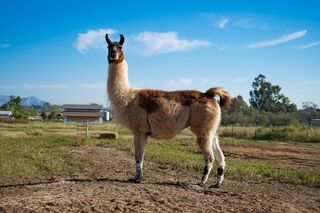FAQs
Why Pack Llamas?
When packing for a multi-day backcountry adventure, weight is always a concern. Many things you’d like to bring are too heavy to be lugged through the rough terrain. Llamas solve this problem with their ability to carry 70+ pounds over the toughest terrain without problems. This means you’ll hike further, camp more comfortably, and stay longer.
The most common pack animals for hunters, ranchers, and outdoorsmen in the backcountry of the Western United States are horses & mules. But pack llamas are less prone to injury and illness than these animals. They are also smaller than horses, so they can eat and drink roughly 10% the intake and can go extended periods without drinking water. You can pack less feed and go to areas with limited water.
Llamas can be staked out and left alone for the day at camp while you move to different areas. In addition to being low maintenance, llamas can reach very challenging destinations because they balance 65-70% of their body weight on their front legs. Their feet have a leather pad similar to a dog, and a split toe that creates a larger surface area and allows for better traction. So llamas excel at rocky, steep, and difficult terrain.
All in all, they are safer and easier to handle than horses, don’t spook as easily, and are very quiet on hunting trips. They are calm, docile, and easy to handle, which makes them great with kids and elderly people. All excellent reasons why they’ve been used for packing since ancient indigenous times!
What are llamas ideal for?
- Backpackers and groups looking to take more food and gear into the mountains
- Seasoned backpackers needing to relieve stress on their knees and back
- Hunters who want to carry camp in and game out quickly and effectively
- Backcountry enthusiasts seeking to extend their range
- Unique trips where you’ll need to pack in water
- Climbers who need to take in a lot of climbing gear
- Setting up a base camp to be able to summit multiple peaks
- Exploring multiple lakes or rivers on a fishing expedition
- Packing in supplies to work camps, trail maintenance crews or lookout stations
- Setting up your own drop camp
- Sightseeing and photography tours
- Hiking portions of the CDT (Continental Divide Trail) or PCT (Pacific Crest Trail)
How do llamas differ from alpacas?
Adult alpacas are 120-180 pounds. Adult working llamas’ weigh 350-430 pounds. Size and ability are the biggest differences.
Are all llamas pack llamas?
No. CCARAs are the working llamas and have the best stamina, muscling/strength, and overall pack ability. There are actually very few pack llamas in North America that are bred, raised, trained, and conditioned for endurance packing. Living beside the Cleveland National Forest has given us a unique opportunity to test, prove and select top end pack llamas for sale, rental, and breeding.
Do llamas like to pack?
Yes! The Ccara llama was bred specifically for packing, so it’s been in their nature for centuries. They live to pack. If they couldn’t pack, they would spend their lives sitting in a pen, eating the same hay day after day, which isn’t a very good life for them.
How much weight can llamas carry?
Packers carry on average 70-80 pounds each, but some of the strongest packers can carry up to 100+ pounds. Llamas carry 22-25% of their body weight when trained and conditioned properly. It all starts with the right breeding.
How far or fast can llamas go?
The average packer llama can go 4-9 miles per day with a layover day every 2-3 days. Commercial packers can go up to 12-15 miles per day, however this is the exception.
What kind of gear is needed to pack with llamas?
Each llama needs a saddle, blanket, halter, two panniers, lead rope and a stake out lead. Also, you will need a brush for brushing them and a scale for measuring the panniers.
How much do llamas weigh?
Top notch packers weigh from 330 to 430 pounds.
How much do llamas eat?
Llamas have a three compartment stomach and will eat 1.5 pounds of dry matter per 100 pounds of body weight per day. 400 pound llamas will need 6-7 pounds per day. When camping in the mountains, select sites that have ample green forage so you’ll only need to pack in feed for the llamas during fall and winter conditions, unless high quality green forage is sparse. When you supplement llamas in the backcountry with pellets or hay, they will need to drink more water to avoid urinary infection and kidney problems.
How often do llamas drink?
You can lead a llama to water, but can’t force it to drink. They may choose not to drink some days, but llamas do need fresh clean water available to them daily. Make sure they don’t skip drinking two more days in a row. Llamas don’t drink as much as a horse.
Do llamas do well in hot dry conditions and cold winter conditions?
Llamas regulate temperature exceptionally well for animals. They can have problems in the extreme heat and extreme cold. When facing these extremes it is best to use caution to mitigate any problems the llamas or you might have. Feel free to contact us regarding specific conditions you might be facing.
Do you have to put shoes on llamas like horses?
Llamas do not wear shoes like a horse. They have a split toe similar to the split hoof of bighorn sheep or mountain goats. They also have a soft pad much like a dog or camel. This gives them superior stability and traction in steep, rocky, cliffy, loose, or hard terrain.
How well can they see/hear/smell?
Much better than humans can. Their vision and hearing are their best instincts.
How do llamas perform in grizzly and wolf country?
Llamas are very alert and attentive. They typically know when something is wrong. If they see or sense a wolf or grizzly they usually make a loud alarm sound with their voice that can alert you of potential danger. This often also chases away the predator. Use caution in bear country by cooking away from your tent and using bear hangs and electric fences. An old outfitter trick is to bring a radio and extra batteries and keep it turned on when you leave camp. This helps lower your bear exposure dramatically.
Are llamas good guard animals?
As pack animals, they love protecting the herd and make fantastic guard animals for sheep, goats, chickens, etc.
Can you ride llamas?
For the safety of llamas and people, we don't recommend anyone ride llamas.
Do llamas spit?
Yes, they do but typically only at each other or when in danger. Trained packers typically do not spit at humans, but a protective mama llama guarding her newborn baby might. If a llama has been raised as a pet, they may think that humans are fellow llamas and may spit at you, but this is uncommon.
Why do llamas hum?
Nobody really knows why a llama hums...But we have lots of ideas about this!
When is a llama considered fully trained for packing?
A fully trained llama is four years old and it takes two years of training before they are ready for full-service trips.
How much do llamas cost?
Our quality trained packers are usually at least 5 years old or more and have over 500-1000 miles of pack experience in the backcountry including many overnight or multi-day pack trips. Prices range from $4,500 to $7,500 for proven packers. Breeding stock currently ranges from $5,000-$10,000 based on the animals age and proven track record of delivering quality offspring.
If llamas are pack animals, how many do I need to have?
Llamas need to be in a pack of at least two.
What is the llama lifespan?
A mature healthy llama lives to 17-24 years. But they have been known to live up to age 28!
How much lupine is harmful for a llama to ingest?
A llama may foam at the mouth for 2 days if they eat a solid mouthful of lupine with seed pods. If a llama ingests even just 4 plants, it could be fatal.
How can a llama assist me as a big game hunter?
Go further - if there’s a dream spot calling your name, but you’re concerned it’s too far to harvest an animal plus get it out before the meat spoils, packing with llamas solves the dilemma. Llamas can take out almost any size of elk or deer. Remote area + low hunting pressure + good habitat = lots of game!
Stay longer - with llamas you can hunt til the last minute. With a pack string of 3-4 llamas you could harvest an animal near last light, quarter it up, load it on the llamas, and get your entire camp out in just one trip. This means more time hunting!
Hunt harder - llamas allow you to pack in food you couldn’t possibly bring in a backpack. Better meals with higher caloric intake and fresh meat, vegetables and fruit means a bigger boost of energy to stay more intently focused for longer in extreme conditions. Llamas can also shuttle your meat and camp around as conditions change. They let you pursue big game at times and locations you’d otherwise pass up and potentially miss a golden opportunity!
Do llamas have a problem with the smell of dead game, like bear, elk, wolf, or deer?
Not all llamas will react the same. Young llamas and beginners need to be introduced to new things slowly with patience and understanding. Once they understand what is expected of them, there is little concern after that. However, it is always good to be cautions and approach dead animals and new situations with caution. Experienced llamas have packed elk, deer, moose, bighorn, coyotes, wolves, bear and mountain lions and never had them loose control.
How many llamas are required to pack out a deer?
One llama can typically pack out an entire quartered deer - head and all. It would be advised to use two llamas to pack out large mule deer on extremely long treks.
How many llamas are necessary to pack out an elk?
Three llamas can pack out a quartered elk including back straps, tenderloins, neck, brisket, rib meat and the head. For very large elk, 4-5 llamas are best, especially if you are going more than 7 miles in steep country. In short, each elk or deer could weigh more or less than the last one you harvested, so the user should not exceed weight limits for each llama and might have to plan to make multiple trips.
Why would I rent llamas for hunting?
- Live in urban areas and aren’t able to own pack llamas
- Don’t have friends available to help pack your game out
- Hunt an area that is 1-2 days hike from your vehicle
- Don’t know anyone with horses
- Have friends with pack animals, but they are currently being used
- Have harvested your game the day before you need to be back at work
- Can’t afford owning pack stock
- Have bad knees or a bad back
- Have shot an elk and the temperature is rising, but you know even 3-4 solo trips with meat on your back isn’t enough to get your elk out fast enough to save it from spoiling
Can llamas assist me on fishing expeditions?
Yes! Llamas make the perfect companion for packing fishing and camping gear far into the wilderness due to their docile nature, athleticism, and sure footedness around rivers/creeks. So say goodbye to heavy backpacks and hello to camping comfortably deep in the backcountry! No matter your age, the distance, or terrain, hardy pack llamas make your wildest fishing adventures possible.
Can pack llamas help me reach new heights in my photographic endeavors?
Absolutely! Llamas are useful for carrying a wide selection of camera gear to spectacular, secluded locations. They reduce the expedition’s stress so you can just focus on capturing nature’s beauty. They’re also quite photogenic themselves if you wish to make them part of your shots!
Can backpackers with small children benefit from llamas?
They sure can! You can 100% continue your hard core backpacking passion long after having children! Pack llamas make backpacking with kids manageable, fun, and educational. Even little tykes can have a role to play in helping manage llamas on the trail or at camp.
Thursday, May 23, 2024









